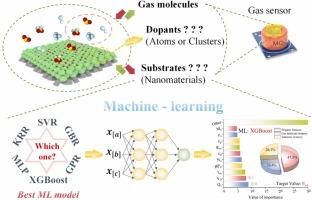当前位置:
X-MOL 学术
›
J. Hazard. Mater.
›
论文详情
Our official English website, www.x-mol.net, welcomes your
feedback! (Note: you will need to create a separate account there.)
A machine learning feature descriptor approach: Revealing potential adsorption mechanisms for SF6 decomposition product gas-sensitive materials
Journal of Hazardous Materials ( IF 12.2 ) Pub Date : 2024-11-19 , DOI: 10.1016/j.jhazmat.2024.136567 Mingxiang Wang, Qingbin Zeng, Dachang Chen, Yiyi Zhang, Jiefeng Liu, Changyou Ma, Pengfei Jia
Journal of Hazardous Materials ( IF 12.2 ) Pub Date : 2024-11-19 , DOI: 10.1016/j.jhazmat.2024.136567 Mingxiang Wang, Qingbin Zeng, Dachang Chen, Yiyi Zhang, Jiefeng Liu, Changyou Ma, Pengfei Jia

|
The man-made gas sulfur hexafluoride (SF6) is an excellent and stable insulating medium. However, some insulation defects can cause SF6 to decompose, threatening the safe operation of power grids. Based on this, it is of great significance to find and effectively control the decomposition products of SF6 in time. Gas sensors have proven to be an effective way to detect these decomposition gases (SO2, SOF2, SO2F2, H2S, and HF). Nanomaterials with gas-sensitive properties are at the heart of gas sensors. In recent years, data-driven machine learning (ML) has been widely used to predict material properties and discover new materials. However, it has become a major challenge to establish a common model between material properties derived from various types of calculations and intelligent algorithms. In order to make some progress in addressing this challenge. In this work, 250 data sets were extracted from 52 publications exploring the detection of SF6 decomposition products by nanocomposites based on relevant work over the past 10 years, and the adsorption behavior of SF6 decomposition products can be predictively analyzed. By comparing six different algorithmic models, the best model for predicting the adsorption distance (XGBoost: R2 = 91.94 %) and adsorption energy (GBR: R2 = 78.63 %) of SF6 decomposed gas was identified. Subsequently, the importance of each of the selected feature descriptors in predicting the gas adsorption effect was explained. This work combines first-principles computational results and machine-learning algorithms with each other to provide a new research idea for evaluating the gas sensing capability of nanocomposites.
中文翻译:

机器学习特征描述符方法:揭示 SF6 分解产物气体敏感材料的潜在吸附机制
人造气体六氟化硫 (SF6) 是一种优良且稳定的绝缘介质。然而,一些绝缘缺陷会导致 SF6 分解,威胁电网的安全运行。基于此,及时发现并有效控制 SF6 的分解产物具有重要意义。事实证明,气体传感器是检测这些分解气体(SO2、SOF2、SO2、F2、H2S 和 HF)的有效方法。具有气体敏感特性的纳米材料是气体传感器的核心。近年来,数据驱动的机器学习 (ML) 已被广泛用于预测材料特性和发现新材料。然而,在从各种类型的计算和智能算法得出的材料属性之间建立一个通用模型已成为一项重大挑战。为了在应对这一挑战方面取得一些进展。本工作从52篇出版物中提取了250个数据集,基于过去10年的相关工作,探索了纳米复合材料对SF6分解产物的检测,可以预测性地分析SF6分解产物的吸附行为。通过比较六种不同的算法模型,确定了预测 SF6 分解气体的吸附距离 (XGBoost: R2 = 91.94 %) 和吸附能量 (GBR: R2 = 78.63 %) 的最佳模型。随后,解释了每个选定的特征描述符在预测气体吸附效应中的重要性。 这项工作将第一性原理计算结果和机器学习算法相互结合,为评估纳米复合材料的气体传感能力提供了新的研究思路。
更新日期:2024-11-19
中文翻译:

机器学习特征描述符方法:揭示 SF6 分解产物气体敏感材料的潜在吸附机制
人造气体六氟化硫 (SF6) 是一种优良且稳定的绝缘介质。然而,一些绝缘缺陷会导致 SF6 分解,威胁电网的安全运行。基于此,及时发现并有效控制 SF6 的分解产物具有重要意义。事实证明,气体传感器是检测这些分解气体(SO2、SOF2、SO2、F2、H2S 和 HF)的有效方法。具有气体敏感特性的纳米材料是气体传感器的核心。近年来,数据驱动的机器学习 (ML) 已被广泛用于预测材料特性和发现新材料。然而,在从各种类型的计算和智能算法得出的材料属性之间建立一个通用模型已成为一项重大挑战。为了在应对这一挑战方面取得一些进展。本工作从52篇出版物中提取了250个数据集,基于过去10年的相关工作,探索了纳米复合材料对SF6分解产物的检测,可以预测性地分析SF6分解产物的吸附行为。通过比较六种不同的算法模型,确定了预测 SF6 分解气体的吸附距离 (XGBoost: R2 = 91.94 %) 和吸附能量 (GBR: R2 = 78.63 %) 的最佳模型。随后,解释了每个选定的特征描述符在预测气体吸附效应中的重要性。 这项工作将第一性原理计算结果和机器学习算法相互结合,为评估纳米复合材料的气体传感能力提供了新的研究思路。


















































 京公网安备 11010802027423号
京公网安备 11010802027423号